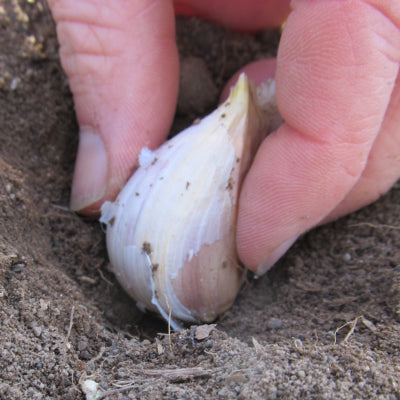
How To Grow Garlic
 Garlic is a power plant. The myths and lore surrounding it have been building up around the world for over seven millennia. It was so popular in ancient times that it is rumored to have triggered the first labor strike. During the construction of the Egyptian pyramids, the builders’ daily garlic ration was removed causing the workers to put down their tools in protest. It’s so powerful that there is a word – Alliumphobia – for those that fear it. Its influence is so strong, that some Hindu and Buddhist monks avoid it, so as not to stimulate their aggressive desires or be tempted by its aphrodisiac qualities. And it’s so celebrated that here in the Hudson Valley, we have a whole festival devoted to it, and we’re not unique in that phenomenon. To the home gardener, garlic is a gastronomic savior, an indispensable medicine in the home apothecary, and a fairly easy crop to grow.
Garlic is a power plant. The myths and lore surrounding it have been building up around the world for over seven millennia. It was so popular in ancient times that it is rumored to have triggered the first labor strike. During the construction of the Egyptian pyramids, the builders’ daily garlic ration was removed causing the workers to put down their tools in protest. It’s so powerful that there is a word – Alliumphobia – for those that fear it. Its influence is so strong, that some Hindu and Buddhist monks avoid it, so as not to stimulate their aggressive desires or be tempted by its aphrodisiac qualities. And it’s so celebrated that here in the Hudson Valley, we have a whole festival devoted to it, and we’re not unique in that phenomenon. To the home gardener, garlic is a gastronomic savior, an indispensable medicine in the home apothecary, and a fairly easy crop to grow.
One of the last planting tasks in the garden, at least here in the Northeast, is getting garlic in the ground. When you plant garlic in the fall, you are putting-it-to-bed since it needs a cold cycle to perform well. Read on to discover how much garlic to plant, how to choose a great location, and how and when to plant it.
1. Quantity
How much you plant depends on what you want out of your crop.
The shortest answer is that 1 pound can plant between 15 and 30 feet depending on the variety, and the amount of space you give it. (That's a single row. Space rows 12 inches apart in whatever bed system you use.)
Each pound of garlic can produce between 50-75 heads of garlic, since each clove can produce a head. If you would like to produce your own seed stock and your own eating stock, plan to reserve the top 30% of your harvest for planting.
2. Location
Since we follow a vegetable rotation, we know where our garlic will be well ahead of planting time. This gives us plenty of time to make sure the beds are well worked, weeded, amended and prepared.
1. First, pick your site. Garlic prefers rich, well-drained, weed-free soil and full sun. Ideally, pick a spot that is in full sun from winter through spring. It can be difficult to grow a crop in your weediest beds, so consider this when scouting during the summer.
2. Consider your mulching options. In wet winters, mulch plays an important role in keeping your garlic seed tucked safely in the soil. Without mulch, you risk your garlic seed popping out of the soil during frost-heave (the uplift of water-saturated soil due to expansion and contraction during the freeze-thaw cycle). Compost, aged manure, and weed-free hay or straw mulch are good choices. Give yourself plenty of time to get this figured out. Don't leave it for later lest you forget!
3. A few days prior to planting, prep your site. Visit our bed prep post for tips on how to get a good, even garden bed.
3. Planting Garlic.
Pick a sunny day in early to mid-October (in the Northeast), when the soil is still warm. Try to leave enough time before the ground freezes solid for the garlic to set roots. Garlic can be planted any time before the ground freezes solid, though, ideally 3-6 weeks prior.
4. Spring growing conditions and care.
Garlic begins to poke through the ground as soon as the soil warms. If you covered your garlic with a thick mulch layer, rake it back to help warm the soil faster. Return the mulch into place after the garlic is up and growing. (Or you can just wait for it to poke up through the mulch—this will just sacrifice a week or two of growing time.)
Garlic prefers rich, weed-free soil and ample water. As spring weeds begin to emerge, pull them when small, taking care not to damage your garlic when pulling them out. Hardneck varieties produce garlic scapes in the spring. If left on the plant, the scapes will draw energy from the bulb, reducing size and quality. Once the scapes emerge, cut them off immediately to direct the plants' energy into bulb production. The scapes are an edible spring delicacy.
5. Fertility.
Garlic thrives in highly fertile soil. In the fall, plant garlic into well-composted beds. In the spring, give your garlic a nutrient boost in the form of alfalfa meal or an additional side-dress of compost.






